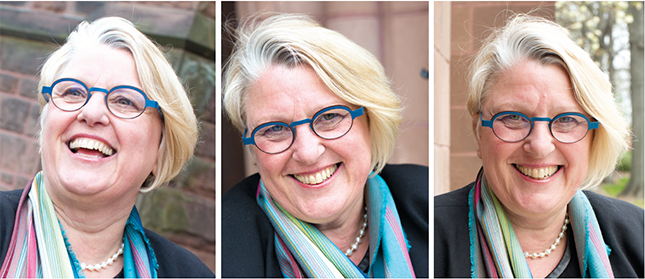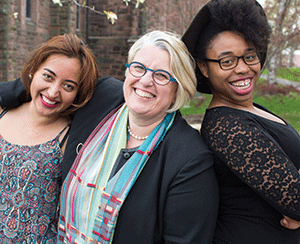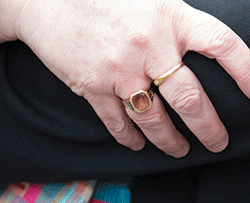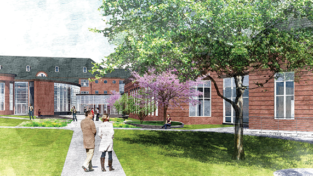A Degree of Continuity
After three years as the College’s dean of faculty, Sonya Stephens steps into the role of acting president of Mount Holyoke

Just before Sonya Stephens received the torch—literally and figuratively—from outgoing president Lynn Pasquerella ’80 in a student-organized “Olympic” ceremony in the spring, the Alumnae Quarterly sat down with the College’s next leader to talk with her about her transition from vice president for academic affairs and dean of faculty to the work that she plans to focus on during her appointed three-year term as the College’s acting president.
As the College’s chief academic officer since joining the administration in 2013, Stephens, a scholar of nineteenth-century French literature and culture, has led colleagues’ efforts to re-imagine the Mount Holyoke curriculum, reduce class sizes, develop innovative learning spaces, enhance faculty research support and compensation, and recruit the faculty of the future. She is also leading the College’s reaccreditation, a lengthy and complex self-evaluation process required every ten years.
On the day we met, Stephens was preparing to distribute The Plan for Mount Holyoke 2021—a project the board of trustees charged her with in January as a part of the transition. Excitedly, she started to talk about the work before we had even settled into her office in Mary Lyon Hall, just one floor below the president’s office, which she moved to in July.
Alumnae Quarterly: So tell us what the strategic plan means for Mount Holyoke.
Sonya Stephens: The Plan for Mount Holyoke 2021 is built around three questions and develops goals from these questions. What does it mean to be a women’s college in the twenty-first century? What is distinctive about the liberal education that Mount Holyoke offers? And how do we build a sense of belonging and togetherness on campus and in the larger Mount Holyoke community to keep us connected in meaningful ways?
The Plan takes a close look at all that we do through the kind of institutional self-study and critical reflection required by the reaccreditation process, as well as by our own goals of self-improvement and effectiveness, and our standards of excellence. It includes a vision to enhance campus infrastructure and teaching in ways that privilege and encourage the kinds of high-contact learning and intellectual exchange that are the hallmark of the Mount Holyoke experience, as well as for new programs and forms of learning that connect the liberal arts to research or pre-professional opportunities. The Plan also articulates the ways in which Mount Holyoke will further develop distinctive global educational experiences, leverage the exceptional resources of the campus for applied learning and environmental awareness, and prepare students for inclusive leadership in a range of post-graduation pursuits.
AQ: Can you talk more specifically about what this means for students?

Stephens shared a moment with Karla Villalta ’16 (left) and Eugenie Elie ’16 before Strawberries & Champagne in April.
SS: There’s a lot in the Plan for students! First and foremost, the Plan envisages a college experience that is shaped by the diversity of our student body, which is a real distinction. The Plan articulates a commitment to take on the challenges of difference and to embrace them, with students collaborating in learning, discovery, engagement, and change, and leading to eliminate discrimination of all kinds in our own community and beyond. The Plan also talks about enhancing campus social traditions and creating new opportunities for social and intellectual engagement and cohort-building. There’s more: new programs, new experiences in a system we are describing as the “liberal arts +,” integrated advising, enhanced residential life, new ways of learning, a focus on the local/global, and programmed and impromptu social opportunities.
AQ: In September the College anticipates celebrating a groundbreaking ceremony for the new Community Center. Can you talk a little bit about the significance of this project to the vibrancy of the campus community and how it relates to the infrastructure needs outlined in the strategic plan?
SS: The Community Center is a new social and creative hub for the campus. During the planning process we kept coming back to the importance of “copresence” in a residential learning environment. It sounds obvious, because that’s what makes Mount Holyoke memorable for generations of alumnae. Students, faculty, and staff represent a community of individuals committed to thinking together, working together, and eating and talking together in ways that are truly transformative for us all, and especially for our graduates. Learning has evolved. The campus has evolved. And the students have evolved. Collective intellectual endeavor and social interaction are becoming harder than ever in an age when we are glued to our electronic devices, network with friends through social media, and access information remotely and continuously.
We have a unique opportunity in this moment to create an engaging forum that will connect the Mount Holyoke community in intellectual and social exchange through curricular and cocurricular infrastructure that increases copresence, as well as through networks powered by social media. The Community Center will be the “third place.” We have homes and offices, and then we gather to be in a social environment to meet, talk, and to seek perspective that enhances our creativity.
Oh yes, and did I mention the pub?
Read more about the Community Center
There is no better way to get to know the College than to talk with alumnae. Every story shared tells a little bit about the institution and what it means to each alumna.
Sonya Stephens
AQ: Let’s switch our focus to alumnae. Within just a few weeks of arriving at Mount Holyoke, you flew to Warsaw, Poland, to participate in the Alumnae Association’s European Symposium. Can you talk a bit about the experience of meeting alumnae out in the world?
SS: It was a privilege to meet alumnae so early on in my time at the College, and those of you who stayed up late with me in conversation know who you are! It’s been a pleasure to continue those conversations on campus and around the world. There is no better way to get to know the College than to talk with alumnae. Every story shared tells a little bit about the institution and what it means to each alumna. The class histories that are presented at the Alumnae Association meetings during reunion weekends similarly represent a connective fabric of memories and experiences that lend texture to the life of the College and celebrate membership of it, set against a changing political backdrop of evolving social expectations and opportunities. At the same time, my conversations with alumnae are also always about the present—what is happening at Mount Holyoke, the work of exceptional faculty, new curricular opportunities—and very much about the ways in which alumnae can help, connecting current students to their professional networks, contributing their experience and expertise, and serving as role models and mentors for new generations.
AQ: In May 2015 you were named an honorary member of the class of 1955 when the class was on campus celebrating its sixtieth reunion. And in April of this year you were honored again by the class during a ceremony at the home of Class President Joan Winkel Ripley ’55. Can you talk about what that meant to you?

Stephens was celebrated by the class of 1955 in April.
SS: The class of ’55 just keeps surprising me! I was drawn into their lives the very first evening I met them, again through the sharing of their stories—of a Mount Holyoke with smoking rooms, overnight absence approvals, and restrictions on sunbathing, chewing gum, and knitting. Over time, those stories and encounters have turned to friendship and developed in me a sense of belonging that I see as characteristic of an MHC class. In April they enacted a May Queen ritual for me and other honorary members of the class, with songs, memorabilia, and memories of their now sixty-five years of association with each other and the College. I learned from their Supplementary Handbook of Social Regulations that the Stimson Room was to be used only for “recreational reading”; that no typewriters or bottles of ink were allowed in living rooms; that sun lamps were forbidden; and that the only male guests allowed in their rooms (without special permission) were their fathers—and then only after church on a Sunday, and no later than 6:00 p.m.! It has been both a lot of fun and extraordinarily moving to be welcomed as a member of the class of ’55—and you will see me wearing a class ring, a cherished gift from Nancy Nutting Lane ’55, as a symbol of our friendship and a talisman.
AQ: What about students? What do you want them to know about you and the work that you intend to pursue?
SS: I’ve always loved my work with students, from the time I was an assistant professor, living in a residence hall at Royal Holloway, University of London, to my work focused on undergraduate education at Indiana University. I am excited to work more closely with Mount Holyoke students and to think with them about what we can do together over the next three years, especially in relation to the priorities of the strategic plan. I’ve already started talking with student leaders about the ways in which we can work together. One of the things I’d like to do is to implement a student think tank that complements the Student Government Association and engages students in longer-term projects that will continue to make Mount Holyoke great for students. I envision a group of maybe six to eight students who will focus on one topic each year. They’ll research and present findings and make recommendations to the administration in order to institute lasting change on campus. I’m also thinking about the role I can play in helping to cement students’ bond to the campus community, sustaining traditions, and maybe creating some new ones. Watch this space!
AQ: Is there anything else you would like the Mount Holyoke community to know about you as we go forward into the next few years?
SS: It seems that I already have a reputation for laughing! That must be because there is always something to enjoy about the work we are engaged in and the relationships we build in that work together. I’m serious about that . . .
—Interviewed by Jennifer Grow ’94
—Photos by Meredith Heuer
This article appeared in the summer 2016 issue of the Alumnae Quarterly.
July 15, 2016










I first met Acting President Stephens in September 2013 at the European Alumnae Conference in Warsaw, Poland. I’d like to think that I’m one of the alumnae who stayed up late in conversation that she mentioned in her comments about alumnae above! I’ve been a fan ever since. She is thoughtful, sensitive and accessible.
I am a member of the Class of 1965. Mount Holyoke, and the world, were very different then.
I have been enriched by my time on campus and the attendance at two European Alumnae Conferences in the last five years, including a class minireunion, preparing for our 50th reunion and the glorious 50th itself. Spending time and conversing with acting President Stephens, past President Pasquerella, and many students, especially our granddaughter class of 2015, has assured me that our College is led by some extraordinary people and populated with outstanding, diverse students from around the world. Never Fear Change